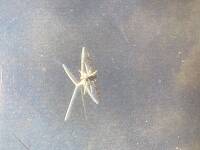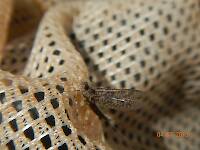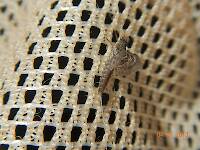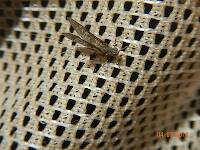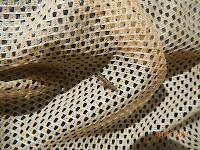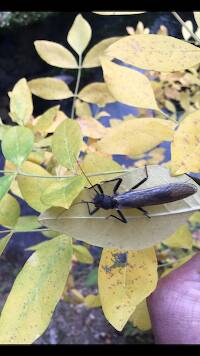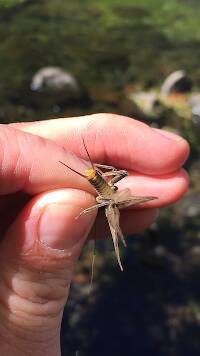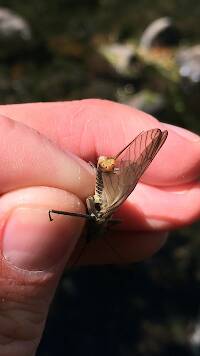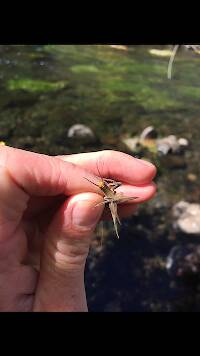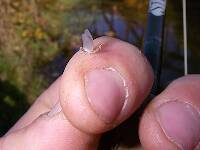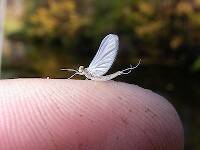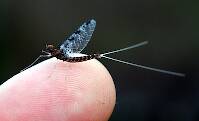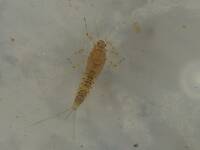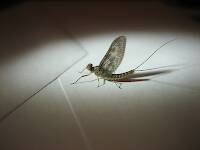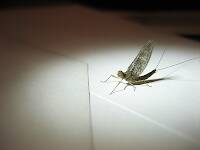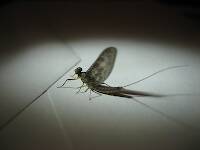
Hex Mayflies
Hexagenia limbata
The famous nocturnal Hex hatch of the Midwest (and a few other lucky locations) stirs to the surface mythically large brown trout that only touch streamers for the rest of the year.
Featured on the forum

This one pretty clearly keys to Kogotus, but it also looks fairly different from specimens I caught in the same creek about a month later in the year. With only one species of the genus known in Washington, I'm not sure about the answer to this ID.

Troutnut is a project started in 2003 by salmonid ecologist Jason "Troutnut" Neuswanger to help anglers and
fly tyers unabashedly embrace the entomological side of the sport. Learn more about Troutnut or
support the project for an enhanced experience here.
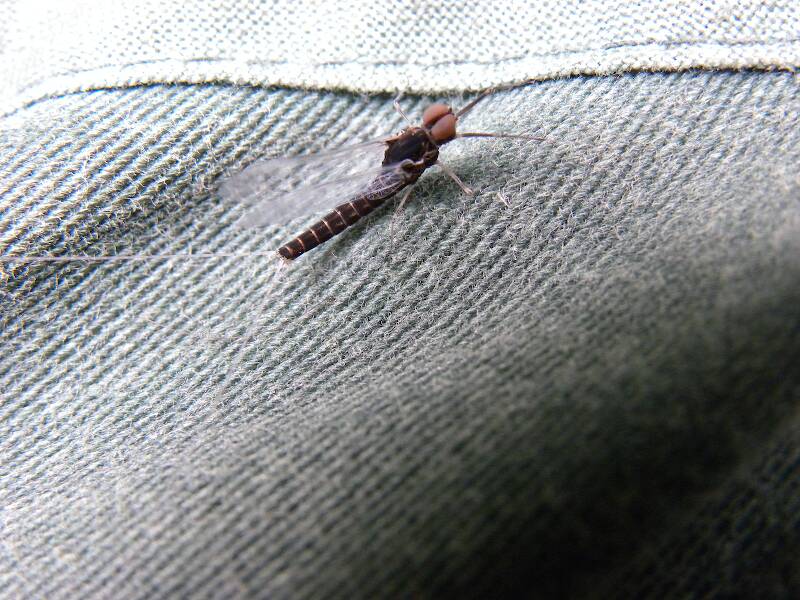
Fredw on Jun 25, 2013June 25th, 2013, 7:33 am EDT
I snapped this pic close to 100 mile house BC and would like to find out some more information about him. Spinners were sporadic around noon June 15 Unfortunately this is the only shot that I have. I would guesstimate him about a size 12. Any help is greatly appreciated.
Fredw on Jun 27, 2013June 27th, 2013, 7:58 am EDT
Thanks for the reply Mack.
I thought maybe B.Vagans but wasn't sure. UBC has 5 Baetidae species listed in their database but vagans was not one of them so I'm still not sure.
Fred
I thought maybe B.Vagans but wasn't sure. UBC has 5 Baetidae species listed in their database but vagans was not one of them so I'm still not sure.
Fred
Entoman on Jun 27, 2013June 27th, 2013, 9:56 am EDT
Hi guys,
What appears to be highly unusual hind wing venation has me stumped. Baetis hind wings have few veins and even fewer crossveins. The "mosaic" look I'm seeing is entirely different.
If it weren't for them I would think it one of many polytypical forms of B. tricaudatus. There is much to work out with western baetids in the Rhodani group, particularly with large solid dark abdomen specimens that keep showing up in samples of late from throughout the region. B. magnus and diablus are both examples of large dark baetids in this group that may eventually be considered forms of tricaudatus. B. tricaudatus is by far our most important western baetid. B. bicaudatus is a much smaller fly and usually has lighter tergal coloration on some segments as do the smaller forms of most tricaudatus.
What appears to be highly unusual hind wing venation has me stumped. Baetis hind wings have few veins and even fewer crossveins. The "mosaic" look I'm seeing is entirely different.
If it weren't for them I would think it one of many polytypical forms of B. tricaudatus. There is much to work out with western baetids in the Rhodani group, particularly with large solid dark abdomen specimens that keep showing up in samples of late from throughout the region. B. magnus and diablus are both examples of large dark baetids in this group that may eventually be considered forms of tricaudatus. B. tricaudatus is by far our most important western baetid. B. bicaudatus is a much smaller fly and usually has lighter tergal coloration on some segments as do the smaller forms of most tricaudatus.
"It's not that I find fishing so important, it's just that I find all other endeavors of Man equally unimportant... And not nearly as much fun!" Robert Traver, Anatomy of a Fisherman
Taxon on Jun 27, 2013June 27th, 2013, 1:09 pm EDT
Hi Kurt-
I believe this male imago to be Callibaetis ferrugineus hageni with unusually distinct abdominal banding. See venation of Callibaetis hind wing:

What appears to be highly unusual hind wing venation has me stumped. Baetis hind wings have few veins and even fewer crossveins. The "mosaic" look I'm seeing is entirely different.
I believe this male imago to be Callibaetis ferrugineus hageni with unusually distinct abdominal banding. See venation of Callibaetis hind wing:

Fredw on Jun 27, 2013June 27th, 2013, 1:18 pm EDT
Thanks for helping out guys. The pic was on my blue jeans. I just checked out the stitching with a pair of Verniers and each stitch is just over 3mm. Also elvevation was around 3000 ft. Hope this helps.
Fred.
Fred.
Cutbow on Jun 27, 2013June 27th, 2013, 2:27 pm EDT
"I believe this male imago to be Callibaetis ferrugineus hageni with unusually distinct abdominal banding."
Except the abdominal and thoracic shape and color would be very unique as well. And the lacking of any speckles on the forewings makes Callibaetis a tough call. I'm not sure if its even a baetid at all. It could be a Paraleptophlebia of some sorts. Although the legs do look like Callibaebitis legs. I dont know.
John
"Once you catch your first fish on a fly you won't care about any other kind of fishing!"
Oldredbarn on Jun 27, 2013June 27th, 2013, 3:49 pm EDT
Good call there Herr Rohrbeck...Wunderbar! It is nice to see you checking in here from time-to-time to help us mind our P's & Q's...;)
Nice followup Mack. So we had, Washington, Ontario, and Northern CA...With a little nephew help from good old Idaho.
By-the-way John...I need to PM you since I'll be out your way soon. I'll be staying in a cabin on Henry's Lake.
Spence
Nice followup Mack. So we had, Washington, Ontario, and Northern CA...With a little nephew help from good old Idaho.
By-the-way John...I need to PM you since I'll be out your way soon. I'll be staying in a cabin on Henry's Lake.
Spence
"Even when my best efforts fail it's a satisfying challenge, and that, after all, is the essence of fly fishing." -Chauncy Lively
"Envy not the man who lives beside the river, but the man the river flows through." Joseph T Heywood
"Envy not the man who lives beside the river, but the man the river flows through." Joseph T Heywood
Fredw on Jun 27, 2013June 27th, 2013, 4:18 pm EDT
Thanks once again for the help. Initially I was going by information that I had from a bc gov website listing the genera , family and species.
http://www.ilmb.gov.bc.ca/risc/pubs/aquatic/mayfly/index.htm
I have a number of periodicals (macafferty, haefel and hughes, knopp and cormier, schwiebert, meck etc.) which I tried cross referencing and found myself lost and that is the reason for my post.
The only calibaetis that I found on the above website was C. americanus
Are we still going with Calibaetis
thanks again for the help
Fred
http://www.ilmb.gov.bc.ca/risc/pubs/aquatic/mayfly/index.htm
I have a number of periodicals (macafferty, haefel and hughes, knopp and cormier, schwiebert, meck etc.) which I tried cross referencing and found myself lost and that is the reason for my post.
The only calibaetis that I found on the above website was C. americanus
Are we still going with Calibaetis
thanks again for the help
Fred
Taxon on Jun 27, 2013June 27th, 2013, 4:34 pm EDT
Hi John-
It is not unusual for a Callibaetis ferrugineus hageni male imago to have completely clear wings, as can be seen in this photo scanned from page (66) of Phillip Rowley's excellent book, Fly Patterns For Stillwaters: A Study of Trout, Entomology, and Tying.
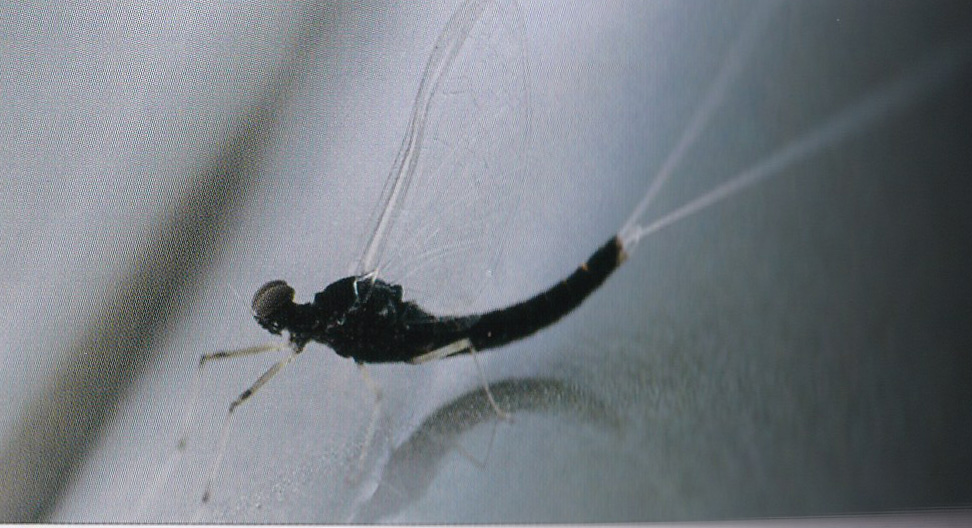
Please also see this BugGuide post, which shows abdominal banding similar to Fredw's image.
Except the abdominal and thoracic shape and color would be very unique as well. And the lacking of any speckles on the forewings makes Callibaetis a tough call.
It is not unusual for a Callibaetis ferrugineus hageni male imago to have completely clear wings, as can be seen in this photo scanned from page (66) of Phillip Rowley's excellent book, Fly Patterns For Stillwaters: A Study of Trout, Entomology, and Tying.

Please also see this BugGuide post, which shows abdominal banding similar to Fredw's image.
Entoman on Jun 27, 2013June 27th, 2013, 11:56 pm EDT
John -
A tough call, but a good call.:) Thanks for the help with this one, Roger.
As noted in my first post, those hind wings preclude Baetis. The eye shape is a good Callibaetis character too. I shouldn't have been stumped but the solid red/brown color (as appears on my iphone) fooled me into not considering them for some reason. Those rings also look unique for the genus. Male Speckled Spinners do have clear wings in some strains but are usually a dark sooty body color and have at least some body speckling in evidence.
BTW - Phil Rowley's photos are probably from BC.
Mack - Some strains of tricaudatus are over 10mm and others close to 5.
A tough call, but a good call.:) Thanks for the help with this one, Roger.
As noted in my first post, those hind wings preclude Baetis. The eye shape is a good Callibaetis character too. I shouldn't have been stumped but the solid red/brown color (as appears on my iphone) fooled me into not considering them for some reason. Those rings also look unique for the genus. Male Speckled Spinners do have clear wings in some strains but are usually a dark sooty body color and have at least some body speckling in evidence.
BTW - Phil Rowley's photos are probably from BC.
Mack - Some strains of tricaudatus are over 10mm and others close to 5.
"It's not that I find fishing so important, it's just that I find all other endeavors of Man equally unimportant... And not nearly as much fun!" Robert Traver, Anatomy of a Fisherman
Cutbow on Jun 28, 2013June 28th, 2013, 12:52 pm EDT
Thank you guys,
I'm glad that I finished with "I don't know." Because I truly didn't. But I do now because of Roger and Mack. :) I don't know where I got the Paralepto idea from other then I was at work and a little rushed when i responded. I'm glad the cuttys in my area don't care what species they're eating, otherwise I would be way behind the power curve. ;)
Spence - PM me buddy. Henry's lake is about 6 hours and 12 minutes from my house. (Give or take a few minutes)
I'm glad that I finished with "I don't know." Because I truly didn't. But I do now because of Roger and Mack. :) I don't know where I got the Paralepto idea from other then I was at work and a little rushed when i responded. I'm glad the cuttys in my area don't care what species they're eating, otherwise I would be way behind the power curve. ;)
Spence - PM me buddy. Henry's lake is about 6 hours and 12 minutes from my house. (Give or take a few minutes)
"Once you catch your first fish on a fly you won't care about any other kind of fishing!"
Taxon on Jun 28, 2013June 28th, 2013, 3:49 pm EDT
Hi Fredw-
The most comprehensive listing of North American mayflies for the province of British Columbia is available at N. American Mayfly Species Query. You need only select the Canadian province of BC, and then click the Search button at the bottom of the entry screen. That will take you to a screen which lists all mayfly species/subspecies "officially" recorded for BC. Clicking on the ? button for a particular species/subspecies will take you to a list of its attributes compiled from the entomology references in my entomology library. Of course, there are much more sophisticated searches which can be performed with this query, but that should at least give you a start.
Best regards,
Thanks once again for the help. Initially I was going by information that I had from a bc gov website listing the genera , family and species.
http://www.ilmb.gov.bc.ca/risc/pubs/aquatic/mayfly/index.htm
I have a number of periodicals (macafferty, haefel and hughes, knopp and cormier, schwiebert, meck etc.) which I tried cross referencing and found myself lost and that is the reason for my post.
The only calibaetis that I found on the above website was C. americanus
Are we still going with Calibaetis
thanks again for the help
Fred
The most comprehensive listing of North American mayflies for the province of British Columbia is available at N. American Mayfly Species Query. You need only select the Canadian province of BC, and then click the Search button at the bottom of the entry screen. That will take you to a screen which lists all mayfly species/subspecies "officially" recorded for BC. Clicking on the ? button for a particular species/subspecies will take you to a list of its attributes compiled from the entomology references in my entomology library. Of course, there are much more sophisticated searches which can be performed with this query, but that should at least give you a start.
Best regards,
Fredw on Jun 28, 2013June 28th, 2013, 4:05 pm EDT
Thanks for all the help guys. Now that it has been established as a Calibaetis what would we be calling it in laymens terms? Would it still be a BWO or maybe a mahogany spinner?
On another note, I have a really neat pic(from the same trip) of a dragon fly sitting on the adjusting strap of my baseball cap. I am not really interested in a Latin name but maybe someone can direct me where to post if anyone is interested.
Once again
Thanks
Fred
On another note, I have a really neat pic(from the same trip) of a dragon fly sitting on the adjusting strap of my baseball cap. I am not really interested in a Latin name but maybe someone can direct me where to post if anyone is interested.
Once again
Thanks
Fred
Taxon on Jun 28, 2013June 28th, 2013, 4:33 pm EDT
Hi Fred-
Dark Specklewing.
Now that it has been established as a Calibaetis what would we be calling it in laymens terms? Would it still be a BWO or maybe a mahogany spinner?
Dark Specklewing.
Quick Reply
Related Discussions
Topic
Replies
Last Reply
18
Apr 5, 2012
by Entoman
by Entoman
11
Apr 24, 2014
by Brookyman
by Brookyman






